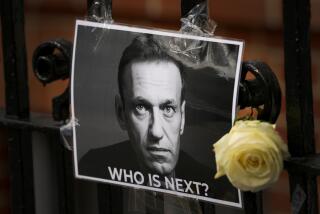Gorbachev Is Attacking Stalinism Itself
Two years after Mikhail S. Gorbachev became the Soviet Unionâs leader in March, 1985, it is clear that he represents the possibility of historic change in that country. If fully implemented, the reforms that he is proposing would greatly reduce the monopolistic system of state control over a society created by Josef Stalin 50 years ago, the only one that most Soviet citizens have ever known. As is evident from the Soviet press and from five visits to Moscow since 1985, this possibility explains Gorbachevâs call for ârevolutionary transformationsâ and the intense resistance that the call has aroused.
The importance of the struggle cannot be understood apart from the history of the Stalinist system--which took shape in the 1930s, not in the 1917 revolution. A less encompassing kind of communist rule existed in the 1920s, the era of Leninâs New Economic Policy. It featured limited state intervention in society, a market economy in which a large private sector competed with nationalized enterprises, a vigorous cultural and intellectual life relatively unrestricted by censorship, and a significant degree of open debate inside the party.
That NEP system was forcibly abolished in the 1930s by Stalinâs policies of draconian industrialization, collectivization and mass terror. They were replaced by a vast hypercentralized bureaucratic state demanding absolute control over almost every kind of social undertaking--from industry, agriculture, trade and consumer services to science and culture. The Stalinist system forged a backward country into a mighty world power, but its survival into the second half of the 20th Century has long been viewed by many Soviet citizens as unworthy of a modern educated nation.
The first effort to reform the Stalinist system, under Nikita S. Khrushchev from 1953 to 1964, achieved important successes. Mass terror was ended, state and party controls were relaxed in various areas, and debates about more far-reaching change were permitted. In these respects Khrushchev prepared the way for Gorbachev. But Khrushchevâs reforms, some of which were reversed during the conservative era of Leonid I. Brezhnev that followed his ouster, stopped far short of challenging the basic Stalinist principle of state control over society.
Therein lies the historic nature of Gorbachevâs proposals to transfer effective management of government-owned industry and agriculture from Moscow ministries to individual factories and farms, to end the stateâs economic monopoly in important areas by encouraging private enterprise and market relations, to reduce censorship over cultural and intellectual activities and to diminish bureaucratic control further by introducing multi-candidate elections to various positions.
Each of these reforms would devolve considerable authority to local workplaces, soviets, unions, theaters, editorial offices and the like, thereby shrinking the size and power of the central state bureaucracies. The new system of âself-governmentâ or âself-managementâ would still be limited by Communist Party domination, but would constitute a substantial de-stateization and liberalization--and thus a fundamental de-Stalinization--of the system.
That such a reformation is the goal of Gorbachev and his supporters is confirmed by their rejection of âhalf-measures,â as were adopted under Khrushchev, and their demand for âa deep restructuring of the entire system.â Indeed, calling on Leninâs NEP for legitimacy, their indictment of the âobsoleteâ Stalinist system now exceeds anything previously allowed. It is, they charge openly, the âbraking mechanismâ on the countryâs development because it still treats everyone like âa cog in a bureaucratic state machine.â
Not surprisingly, Gorbachevâs call for a new way of governance and life has collided with powerful interests and heartfelt attitudes developed over 50 years. Evidence of high-level opposition continues to appear--most recently at the Central Committee plenum in January, which had been postponed three times due to political conflict. The plenum endorsed notably less than Gorbachev proposed. Nor was he able to promote any of his proteges to full Politburo membership. Even if Gorbachev manages to legislate such sweeping reforms, there remains the problem of implementing them through an administrative bureaucracy that does not want them.
His hope seems to be that eventually reformers can erode conservative attitudes that form the most widespread obstacle to change. Here, too, as Gorbachev told the Central Committee, he is in direct conflict with the Stalin era, when âvigorous debate and creative ideas disappeared . . . while authoritarian evaluations and opinions became unquestioned truth(s).â Viewed in this context, his âopennessâ campaign in the media, which has pitted ânew thinkingâ against many Stalinist âdogmasâ about the nature of Soviet socialism, is his most important achievement in two years.
Nonetheless, no doubt sobered by those two years and mindful of the fate of Khrushhevâs lesser reforms, Gorbachev and his supporters now say that the full reformation will require decades. Increasingly they speak of the need to find ways âto make the process of change irreversible.â That realistic expression also reflects the scope of their anti-Stalinist purpose and the tenacious resistance that it is meeting.
Little of this historic struggle has been clearly perceived by American commentators. Until recently, most of them maintained that Gorbachev represented nothing significantly new. Now they seem baffled. Such foggy perceptions prevent the United States from considering the equally historic possibility of a new kind of relationship with the Soviet Union. In addition, they obscure one of the most fateful political dramas of our time.
More to Read
Sign up for Essential California
The most important California stories and recommendations in your inbox every morning.
You may occasionally receive promotional content from the Los Angeles Times.










